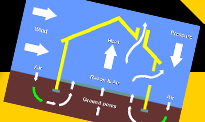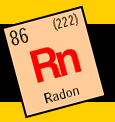
What is Radon?
Radon is a naturally occurring cancer-causing radioactive gas that can be found all over the United States. You can't see it, taste it or smell it. Radon comes from the natural radioactive breakdown of uranium in soil, rock and water and gets into the air that you breathe. It is estimated that radon causes thousands of deaths each year. The Surgeon General has warned that radon is the second leading cause of lung cancer in the United States today, second only to smoking. If you smoke and your home has high radon levels, your risk of lung cancer is considerably higher.
Should I test for radon?
YES! The only way to know if you and your family are at risk from radon is by having a radon test performed by a licensed professional. Radon can get into any type of building and build up to high levels but you and your family are most likely to get your greatest exposure at home because that is where you spend most of your time.
Can high levels of radon be reduced?
YES! The EPA recommends that you take action to reduce your home's indoor radon levels if your radon test results are 4 pCi/L or higher. You can do this by having a Sub-Slab Depressurization System installed by a licensed mitigation professional in your home.
Does Radon cause Cancer?
YES! Radon is a Class A known human carcinogen. If inhaled, radon decay products (polonium-218 and polonium-214, solid form), attach to the surface of aerosols, dusts, and smoke particles, become deeply lodged or trapped in the lungs, where they can radiate and penetrate the cells of mucous membranes, bronchi, and other pulmonary tissues. The ionizing radiation energy affecting the bronchial epithelial cells is believed to initiate the process of carcinogenesis. Although radon-related lung cancers are mainly seen in the upper airways, radon increases the incidence of all histological types of lung cancer, including small cell carcinoma, adenocarcinoma, and squamous cell carcinoma. Lung cancer, due to inhalation of radon decay products constitutes the only known risk associated with radon. The use of tobacco significantly increases the risk of lung cancer.
Radon Reduction Techniques
The EPA recommends methods which prevent the entry of radon. Soil suction also known as Active Reduction prevents radon from entering your home by drawing the radon from below the house and venting it through a pipe, or pipes, to the air above the house where it is quickly diluted. This system should be installed by a licensed mitigation professional.
Should I have my home tested if I am considering selling my home?
YES! If you are considering the possibility of selling your home in the near future you will want to test your home for potentially high radon levels.
The Disclosure Act...
The Illinois Real Property Disclosure Act, effective October 1994, requires that a home seller disclose any knowledge about radon levels in the home. The act does not require that testing or remediation work be conducted. However, many relocation companies and lending institutions, as well as home buyers, request a radon test when purchasing a home. Sellers and brokers are cautioned to err on the side of full disclosure of material facts prior to entering into a purchase agreement.
Building a new home?
Should you take preventive measures during construction?
If you are building a new home there is no reliable way to test the soil before construction. Soil testing has been tried and proven to be unreliable, the end result will always be the same, pre-running pipe will be recommended. Testing the topsoil won't tell you if you will have a problem down below your foundation. There are other factors that will influence the radon level once the home is built. Feel free to contact us at KNOW RADON to inquire as to what percentage of the homes in your area are showing up with elevated radon levels.
REMEMBER! Test Your Home!
Every new home should be tested for radon after occupancy. Test your home even if it has the radon resistant features. Simply contact KNOW RADON and we will have a licensed professional conduct a test for you.
What if your radon levels are still high?
If your home tests at 4.0 picocuries per liter (pCi/L) or above, activate the system by having the fan, electric (if not already installed) and the u-tube meter installed by a licensed mitigation professional.
|









